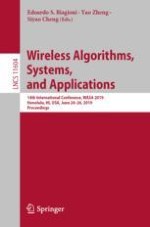This book constitutes the proceedings of the 14th International Conference on Wireless Algorithms, Systems, and Applications, WASA 2019, held in Honolulu, HI, USA, in June 2019. The 43 full and 11 short papers presented were carefully reviewed and selected from 143 submissions. The papers deal with new ideas and recent advances in computer systems, wireless networks, distributed applications, and advanced algorithms that are pushing forward the new technologies for better information sharing, computer communication, and universal connected devices in various environments, especially in wireless networks.
